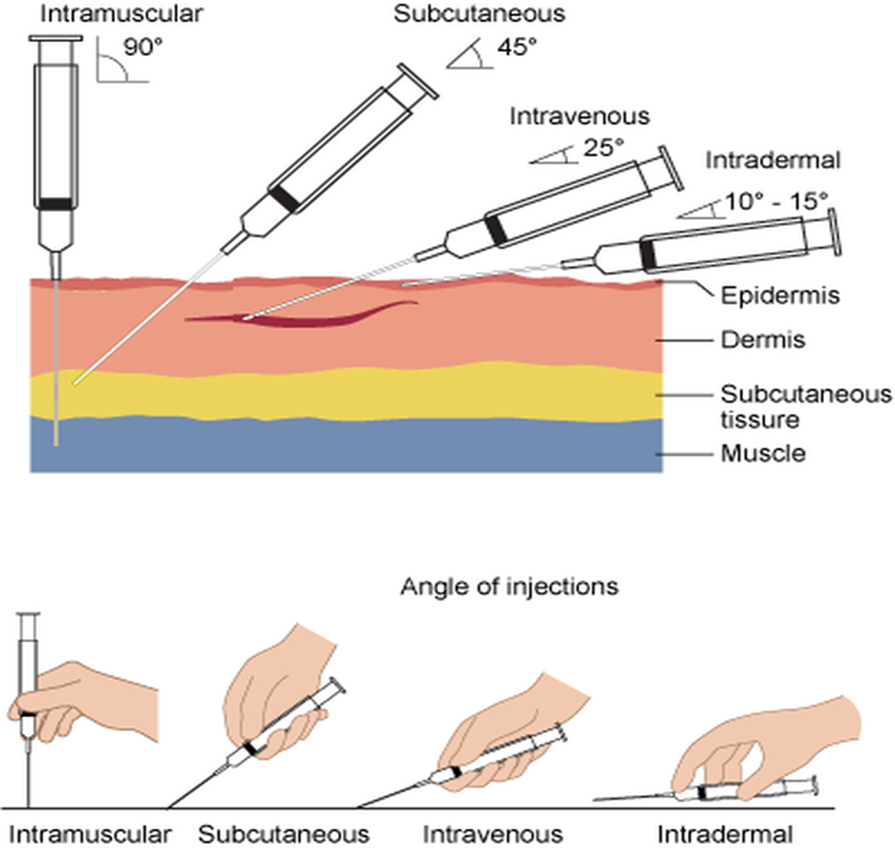A phlebotomist is preparing to perform a venipuncture. Which of the following needle positions should the phlebotomist use?
Bevel down at a 30° angle
Bevel up at a 45° angle
Bevel up at a 30° angle
Bevel down at a 45° angle
The Correct Answer is C
Choice A reason:
Having the bevel down at a 30° angle is not the correct needle position for venipuncture. The bevel of the needle should be facing up to allow for a smoother insertion and to minimize the risk of damaging the vein or causing discomfort to the patient.
Choice B reason:
Positioning the bevel up at a 45° angle is not recommended for venipuncture as this angle is too steep and could lead to the needle penetrating through the vein, potentially causing a hematoma or other complications.
Choice C reason:
The bevel up at a 30° angle is the correct position for venipuncture. This position allows the phlebotomist to insert the needle with the bevel facing upwards, which is the sharpest part of the needle, ensuring a clean entry into the vein. The 30° angle is shallow enough to enter the vein without going through it and causing injury.
Choice D reason:
A bevel down at a 45° angle is incorrect for the same reasons as choice B. Additionally, with the bevel down, the non-beveled side, which is duller, would make the initial contact with the skin, potentially causing more pain and making it more difficult to penetrate the vein.

Nursing Test Bank
Naxlex Comprehensive Predictor Exams
Related Questions
Correct Answer is C
Explanation
Choice A reason:
An alcohol-based hand rub is generally used for hand hygiene when the hands are not visibly soiled. It is effective against many types of microbes but is not the best option for hands that are visibly dirty or contaminated with proteinaceous materials, such as blood or body fluids. The CDC recommends washing hands with soap and water in these situations.
Choice B reason:
Sterile water rinse alone is not sufficient for cleaning hands that are visibly soiled. While sterile water can be used to rinse off debris, it does not have the cleaning or antimicrobial properties necessary to properly decontaminate the hands.
Choice C reason:
Soap and water are the recommended decontamination agents when hands are visibly soiled with blood or body fluids. The physical action of handwashing, combined with the detergent properties of soap, effectively removes soil and transient microorganisms. The CDC guidelines specifically state that hands should be washed with soap and water when they are visibly dirty or contaminated with proteinaceous materia.
Choice D reason:
An alcohol rinse, similar to an alcohol-based hand rub, is not adequate for cleaning visibly soiled hands. Alcohol is a disinfectant that is effective against many germs when used on clean hands but does not remove visible dirt or organic material well.
Correct Answer is B
Explanation
Choice A reason:
A hair cap is used to prevent contamination from the hair, but it is not specifically designed to protect against body fluid splashes. While it is a part of personal protective equipment (PPE), it does not provide coverage for the areas most likely to be exposed to splashes during phlebotomy procedures.
Choice B reason:
A gown is the appropriate choice for protection against body fluid splashes. It covers a significant portion of the body and is designed to prevent fluids from reaching the phlebotomist's skin or undergarments, which is essential when there is a risk of splashes during procedures like venipuncture.
Choice C reason:
Shoe covers protect the feet from contamination, but they are not typically necessary for phlebotomy unless there is a significant risk of large fluid spills on the floor. They are more commonly used in operating rooms or during the cleaning of large spills.
Choice D reason:
Sterile gloves are a standard requirement for phlebotomy to maintain aseptic technique and prevent contamination. However, gloves alone do not provide sufficient protection against body fluid splashes that may reach other parts of the body.
Whether you are a student looking to ace your exams or a practicing nurse seeking to enhance your expertise , our nursing education contents will empower you with the confidence and competence to make a difference in the lives of patients and become a respected leader in the healthcare field.
Visit Naxlex, invest in your future and unlock endless possibilities with our unparalleled nursing education contents today
Report Wrong Answer on the Current Question
Do you disagree with the answer? If yes, what is your expected answer? Explain.
Kindly be descriptive with the issue you are facing.
